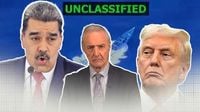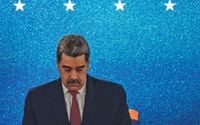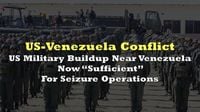President Trump’s dramatic announcement on October 3, 2025, that the United States is now in a “non-international armed conflict” with Latin American terrorist organizations—specifically targeting drug cartels—has sent shockwaves through Washington and across the hemisphere. According to The Economic Times, this declaration reframes the longstanding narcotics crisis as a national security emergency, invoking wartime powers that allow for pre-emptive strikes and even indefinite detention of cartel operatives, now labeled “unlawful combatants.”
The Pentagon has responded with a show of force not seen in years. As reported by the Washington Examiner, a formidable strike group is now positioned off Venezuela’s coast, including Navy destroyers, a submarine, ten F-35 Lightning II stealth fighters, and the 22nd Marine Expeditionary Unit—2,200 Marines equipped with Harrier jump jets, helicopters, and armored vehicles. Special operations units have been conducting parachute drops and airfield seizure drills in the Caribbean, with Puerto Rico emerging as a critical logistics hub. Elite U.S. forces executed high-altitude jumps and runway security exercises in August, far beyond the scope of traditional counter-narcotics patrols.
This military buildup has not gone unnoticed in Caracas. Venezuela’s Defense Minister Vladimir Padrino López revealed that Venezuelan radar had detected five F-35s flying within the Maiquetía Flight Information Region, just off the nation’s coast. These aircraft, believed to be U.S. Marine Corps F-35Bs operating from Puerto Rico, were denounced by Padrino as “deliberate provocation.” Despite the saber-rattling, he insisted that Caracas “will not be intimidated.”
The escalation comes on the heels of a series of deadly maritime operations. In September alone, American forces conducted three strikes against suspected narco-trafficking vessels, resulting in at least 17 deaths—11 on September 2, and another three in a fiery explosion on September 15. President Trump defended these actions on social media, declaring, “STOP SELLING FENTANYL, NARCOTICS, AND ILLEGAL DRUGS IN AMERICA, AND COMMITTING VIOLENCE AND TERRORISM AGAINST AMERICANS!!!”
Yet, the legal and strategic ramifications of this new approach are hotly debated in Washington. In his memo to Congress, Trump argued that cartel smuggling operations “constitute an armed attack against the United States,” drawing a direct line between the drug crisis and national security threats akin to those posed by Al-Qaeda. This shift enables the administration to utilize post-9/11 counterterrorism authorities, but critics warn it is a dangerous overreach. Senator Jack Reed, the top Democrat on the Armed Services Committee, lambasted the administration for providing “no credible legal justification, evidence, or intelligence for these strikes.” Congressional Democrats are now drafting a War Powers Resolution to curb the president’s ability to take further unilateral military actions.
Legal experts and lawmakers alike caution that the president is stretching counterterrorism laws far beyond their intended scope. As one congressional aide told ABC News, “Lawmakers see the move as the administration essentially waging a secret war against secret enemies, without the consent of Congress.” With stealth jets circling Venezuela and American warships poised off its coast, the United States stands on the precipice of a potentially major overseas intervention. Whether this military posturing remains a show of force or escalates into direct action inside Venezuela may hinge on the responses of both Caracas and Congress in the coming days.
But the story doesn’t end at the water’s edge. As detailed in Small Wars Journal, Washington’s view of Venezuelan President Nicolás Maduro has shifted dramatically. No longer seen as merely an authoritarian strongman, Maduro is now regarded as a “hybrid threat”—one who combines repression with criminal enterprise, sustaining narco-trafficking networks tied to the Cartel de los Soles and fueling mass migration that destabilizes the region. The regime’s ties to transnational organized crime and its ability to leverage migration as a pressure tactic have elevated the stakes for U.S. policymakers.
Recent U.S. military deployments in the Caribbean, while focused on interdicting narco-speedboats, are seen by many analysts as tactical steps that do little to change the strategic balance. The real question, as posed by The Wall Street Journal, is whether Washington will escalate to direct strikes on Venezuelan narco-infrastructure—or even consider regime change. Influential voices, such as Latin America scholar R. Evan Ellis, have called for a campaign reminiscent of the 1989 ouster of Manuel Noriega in Panama, a view echoed by some in the U.S. media.
Yet history and doctrine offer sobering lessons. U.S. military counterinsurgency doctrine, as outlined in FM 3-24, warns that decisive operations must be followed by “clear-hold-build” strategies to establish legitimate governance. Without a credible plan for what comes after Maduro, any military action risks creating a power vacuum. Venezuela’s opposition is notoriously fractured, with a 25-year track record of infighting and governance failures. While opposition leaders claim that billions in foreign investment are poised to flow into a post-Maduro Venezuela, the immediate reality would be a humanitarian emergency—millions needing food, water, medicine, and security.
The persistence of Venezuela’s illicit economy—narcotics, contraband, illegal mining, and fuel smuggling—would further complicate any transition. Without deliberate efforts to dismantle these networks and deliver social programs to the most vulnerable, criminal enterprises could thrive even after a regime change. The risk, as Small Wars Journal notes, is that striking Maduro without preparation would not bring stability, but rather a vacuum filled by criminal networks, armed colectivos, and foreign proxies from Cuba and Russia.
Nearly eight million Venezuelans already live abroad, and migration pressures continue to strain regional stability. The ongoing collapse of Venezuela’s economy—over 80% food insecurity and a 60% contraction since 2013—has created dire humanitarian needs. Meanwhile, the security environment is bleak: pro-regime colectivos dominate neighborhoods, the military is deeply entwined with organized crime, and foreign advisors from Cuba, Russia, and China remain entrenched.
For more than two decades, U.S. policy toward Venezuela balanced pressure with restraint, viewing the regime as a costly nuisance rather than a strategic threat. That calculus is changing, but the opposition’s lack of unity and credible governance capacity remains a critical weakness. As recent history in Iraq and Libya demonstrates, regime change without governance planning leads to instability and chaos. By contrast, successful transitions in Poland, Czechoslovakia, and South Africa were marked by careful preparation, unity, and a focus on rebuilding institutions.
As the United States weighs its next steps, voices across the political spectrum urge caution. Some argue that any move to topple Maduro must be accompanied by robust plans for humanitarian relief, security sector reform, and institutional rebuilding. Without such preparation, the U.S. risks inheriting responsibility for a fractured state, with all the attendant humanitarian and strategic burdens. The so-called “Pottery Barn Rule”—you break it, you own it—looms large in the minds of policymakers.
Ultimately, the future of Venezuela hinges not only on the fate of Maduro’s regime, but on whether those who seek to replace it can govern effectively and restore stability. As Washington stands at this crossroads, the stakes—for Venezuela, the region, and the United States—could not be higher.



